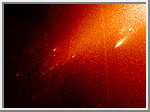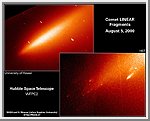
(Courtesy STScI-PR00-27)

|
| Hubble Sees Mini-comet Fragments from Comet Linear. [more information] |
In one observation Hubble's powerful vision has settled the fate of the mysteriously vanished solid nucleus of Comet LINEAR which was reported "missing in action" following its passage around the Sun on July 26.
Though comets have been known to break apart and vanish before, for the first time astronomers are getting a close-up view of the dismantling of a comet's nucleus due to warming by the Sun. The results support the popular theory that comet nuclei are really made up of a cluster of smaller icy bodies called "cometesimals".
Since the 1950s, comet nuclei have been commonly assumed to be loose agglomerations of ice and dust - "dirty snowballs" weakly held together by gravity. Solar heat causes the ices to sublimate and violently release gas as explosions and garden-hose style jets, and the pressure of the solar radiation pressure blows away particles like debris caught in a gale.
In 1992, Comet Shoemaker-Levy 9's nucleus was broken up into about 20 "mountain-sized" pieces after a close encounter with Jupiter. In 1994 these pieces eventually collided with Jupiter in a stunning string of explosions.

|
| Raw Hubble image of Comet Linear fragments. [more information] |
But that comet was too far from the Earth to be studied in the same kind of detail possible with Comet LINEAR. Some astronomers think that the fragments now being seen in Comet LINEAR may be the primordial building blocks of the original nucleus, the so-called cometesimals, which theory predicts should be several tens of feet across. By investigating how Comet LINEAR is coming apart, astronomers hope to learn how it was put together in the first place, roughly 4.6 billion years ago.
On July 27th, ground-based observers had lost sight of the bright core of the comet and were suggesting that the nucleus had totally disintegrated into a pile of dust. Astronomers at the Space Telescope Science Institute (STScI) in Baltimore, Md., quickly reprogrammed Hubble to go looking for the AWOL nucleus. Not expecting to see much, Johns Hopkins University astronomer Harold Weaver was stunned when the Hubble picture popped up on his computer screen. "My first thought was Hubble Space Telescope does it again! We caught the fish! This is amazing, very exciting, very neat."
On Weaver's screen was at least a half dozen "mini-comets" with tails, resembling the shower of glowing fireballs from an aerial firework. They are clustered in the lance-head tip of an elongated stream of dust seen from a ground-based telescope. A notable isolated brighter piece in front of the cluster may be the parent nucleus for the smaller fragments. Hubble's exceptional resolution and sensitivity allowed it to reveal the nuclei as separated bodies at a level of detail never before seen in a disintegrating comet.
In hindsight Comet LINEAR began falling apart in June when the comet unexpectedly brightened, indicating an outburst of dust. Powerful gas jets nudged the comet along a chaotic path, another indication of a very volatile activity. Hubble fortuitously caught a piece blow off on July 5 - which may have been the first of the cometesimals or a piece of crust. Another comet brightening happened on July 20. When the comet went around the Sun on July 26, the Sun's heat made the comet come unglued.
Astronomers using ground-based telescopes were surprised to see no evidence of the pinpoint comet nucleus, the solid body of the comet which is the fountainhead for creating the long gossamer tail of glowing gas and dust. Some astronomers concluded that the small comet probably ran out of ice altogether, leaving behind a loose conglomerate of particles that were gradually dispersing into space. They pointed out that during the comet's closest approach to the Sun, a burst of activity was recorded. That was interpreted as the nucleus completely falling apart.
For other astronomers it was hard to imagine how an object the size of a mountain could totally disintegrate in only two weeks. "Actually, I would have been more amazed if Hubble saw no pieces," comments co-investigator Carey Lisse of STScI. "They just had to be there. The amount of heat available from sunlight just isn't enough to boil away something the size of a mountain in so short a time"
Weaver says it will be important for the largest ground-based telescopes to try and see the mini-comets as they spread apart, presumably into a trail of fragments reminiscent of Comet Shoemaker-Levy 9. This will yield further clues on the structure of the original nucleus and might provide strong constraints on the sizes of the fragments.
Some astronomers believe that this was Comet LINEAR's first visit to the solar system, after traveling for nearly the distance of a light-year from the vast comet storehouse called the Oort cloud. It estimated that 20-30 percent of comet visitors are so fragile they completely disintegrate when they meet the Sun up close. Other comet nuclei can survive for as many as a thousand orbits about the Sun - one of the most celebrated being Halley's Comet which last appeared in 1986.
Other astronomers suggest the LINEAR may itself have been a fragile piece that broke off of a larger comet that visited our solar system more than 10 million years ago. Straggling behind its parent comet for millions of years, LINEAR at last returned to our solar system for one last circuit of the Sun.
The breakup of a comet tells scientists how it is assembled. Its fundamantal building blocks, the cometesimals, were built up from micron-sized grains of dust it collected in the early solar system. The cometesimals gently merged and stuck together to build up comet nuclei, many which were then tossed out of the solar system by the giant planet Jupiter.

 Comets
Comets